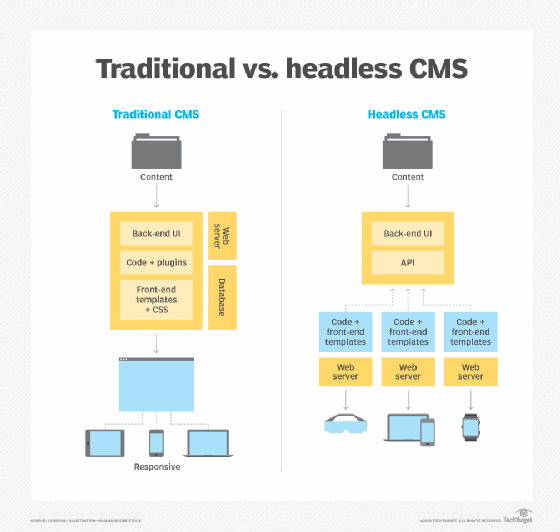
Getty Images/iStockphoto
5 steps to integrate a personalization engine into a CMS
Customer experience is a top focus in the modern business world, and personalized content can go a long way toward delivering that exceptional experience.
Positive digital experiences get the right content to users at the right time. A content personalization engine can help with that.
A personalization engine gathers data on user behaviors, attributes, and preferences and then uses this information to deliver relevant content from the organization's content management system (CMS) to each customer. This process helps engage audiences, as the system learns their preferences and aims to deliver a personalized experience.
Integrated with a CMS, personalization engines can transform the overall customer experience and help organizations better understand their customers' needs and preferences.
What is a personalization engine?
A personalization engine collects and processes data from various sources, such as user profiles, browsing history and purchases. It then applies machine learning algorithms and predictive analytics to make sense of this data, identify patterns and draw insights. As it continuously learns from user behavior, the engine can determine what content or experience is most relevant to every user in real time and improve an organization's approach to personalization.
Personalization approaches can be split into three methods:
- Explicit personalization. This involves knowing the types of content users are interested in based on information about them. That information includes their age, geographic location, or their favorite sports, hobbies, foods or vacations.
- Implicit personalization. This infers what content users may be interested in based on their previous browsing histories or other sources of information. This may include previous purchases recorded in CRM or sales systems, as well as demographic data.
- Contextual personalization. This infers content relevant to a user based on information like the user's location or the time. Computers and smart devices can use GPS or Wi-Fi technology to provide a user's approximate location, while a Bluetooth beacon can provide that individual's exact location.
In all instances, it helps to know some details about the user, such as an email address or phone number, from a previous login. However, anonymous personalization is possible with techniques like IP tracking and cookies through a content personalization engine.
The personalization engine integrates with a content management system -- often a headless CMS -- to add personalization to the content delivery. This integration lets businesses dynamically modify and deliver content based on user attributes, context and goals. As the engine tailors content to each user's needs and preferences, it can improve engagement, conversions and overall customer satisfaction.
How to accomplish a CMS-personalization engine integration
Explore the five steps for integrating a personalization engine with a CMS.
1. Choose the tool set
The personalization engine market includes various vendors, including Adobe, Salesforce and Oracle. Organizations should choose a tool set based on criteria that includes the following:
- Existing technologies.
- Business requirements.
- Required system integrations.
- Teams' skill sets.
- Budget.
2. Incorporate behavior tracking
Organizations can use HTML and JavaScript to deliver web browser content, which can also help them customize certain cookies or data tracking for users' behaviors with their consent.
To track user behavior, IT teams can integrate a JavaScript snippet from the personalization vendor into the applicable webpages. This lets the script record user journeys and save them into a database.
3. Create a metadata tagging scheme
A content personalization engine must be able to pull content from the data published in the headless CMS based on prespecified criteria. For example, a travel site could show vacations that include certain keywords, such as winter sports, Europe, medium price range and deals of the week.
The personalization engine can then match these criteria with information about the user. Teams can also reengineer monolithic pages to break content into smaller chunks so users can more easily digest the information.
4. Develop targeting rules
Personalization is all about rules. For example, if a user is under 25 years old, interested in life insurance and has a salary less than $100,000, then the website should show the user low-cost life insurance products.
5. Create dynamic content
Depending on the incumbent CMS, organizations can use various approaches to create dynamic content, which teams update or edit frequently. Some content personalization engines only plug in to specific CMS products, and others claim to work with all of them.
The techniques are often similar and based on whether the vendor offers a page editor. Organizations can load pages into the editor and manipulate them based on specific rules. Like behavior tracking, the vendor can offer a JavaScript snippet to integrate with a webpage to facilitate this editing capability. Teams can quickly update the content based on JavaScript, rules and definitions as the browser renders the pages.
Personalization engines vs. headless CMS
A headless CMS is a content management system that separates the front-end UX from the back-end content development and management capabilities. This separation can improve performance when serving content to consumers and improve security, as the APIs only let users view -- not update -- content.

A headless CMS architecture can be especially helpful if an organization integrates its CMS with a personalization engine. This type of CMS lets users create and manage content in the back end and then deliver it -- along with custom metadata for personalization -- to a database that the company website and personalization engine can access.
The separation of content creation from delivery means the system can share content and its metadata in an agnostic way, which enables flexibility during integrations with personalization engines.
Other considerations for CMS-personalization engine integrations
If a company uses multiple CMS products, it should consider using a content hub. A content hub acts as the ultimate CMS, combining disparate content silos into a single library. This approach is especially beneficial if the various CMS products are run as headless. They can share content to the hub independent of the CMS and then share it to the website and personalization engine.
Personalization is about considering capabilities across all content delivery channels, such as email, text messaging and other apps. Organizations may need to use different approaches for different channels, which the personalization engine can help with.
Additionally, concerns over privacy and data usage are increasing. Many countries have created legislation, such as GDPR in the EU and CCPA in the U.S., to address these concerns. A facet of GDPR states that companies can no longer capture data without explicit permission from users, and these guidelines are applicable worldwide. An organization shouldn't consider personalization without involving its compliance and regulatory teams.
Editor's note: This article was originally written by Jonathan Bordoli and expanded by Jordan Jones.
Jonathan Bordoli is an experienced technical project manager and solution architect. He has more than 25 years of experience defining, designing and managing technology delivery across the full project lifecycle, with particular emphasis on delivery and adoption of content, collaboration and process improvement solutions.
Jordan Jones is a writer versed in enterprise content management, component content management, web content management and video-on-demand technologies.







